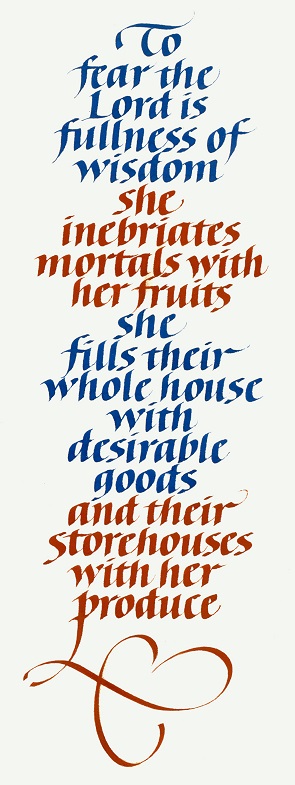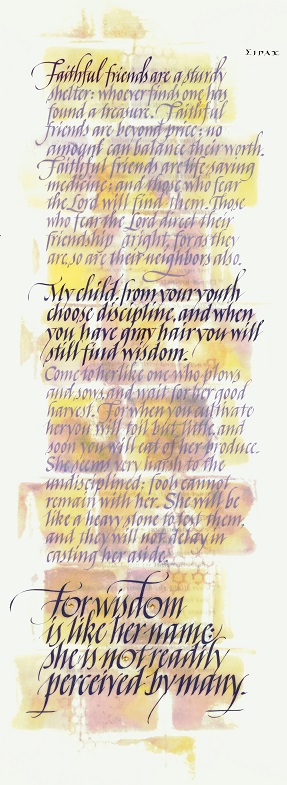St. John’s Bible: Volume 3 – Wisdom
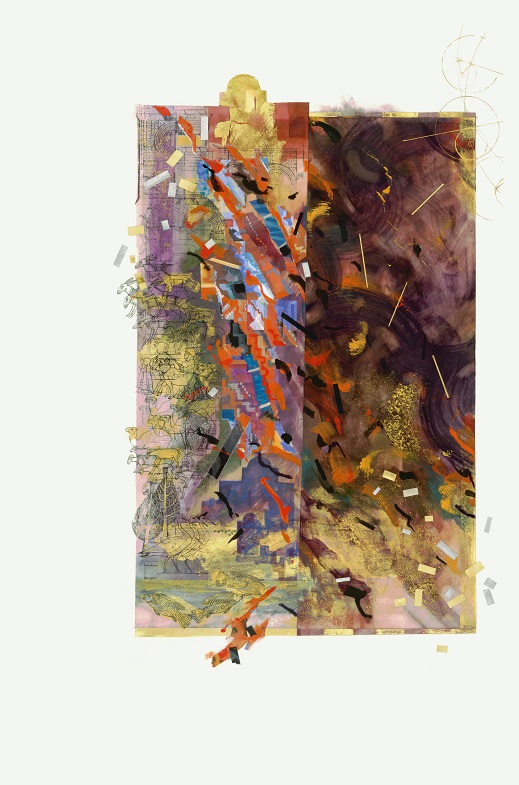
Job Frontispiece
The frontispiece to Job portrays Job’s world. At the top, stamped building arches represent human accomplishment. At the bottom are signs of fertility in the birds and fish. On the left side we see Job’s riches: his cattle, donkeys, camels, and servants. But the animals and servants are fading away, already walking offstage—led into captivity by Job’s enemies. The fire and fractals at the center of the illumination suggests chaos. Only slender bars of gold remain to tell Job that God is still present.
Job’s spiritual journey is traced from top left down to bottom right. In the top left are chunks of silver and gold, a sign of Job’s closeness to God. Through the center of the illumination the bars turn to black, signaling his separation from God. Finally, though, at the bottom right the gold and silver bars return, along with gold stamps. Job’s life is once again permeated with an awareness of God’s presence.
The quotation on the opposite page is from one of Job’s early responses to his suffering: “Shall we receive the good at the hand of God and not receive the bad?” Artist and calligrapher Donald Jackson believes this his best work in all of The St. John’s Bible.
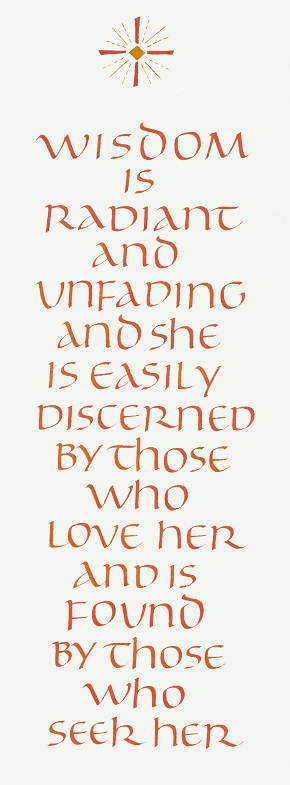

Out of the Whirlwind, Job 38-42
This three-part illumination tells of God’s peculiar and powerful answer to Job: not a consolation, but a series of questions. These bursts of barred words visualize the effects produced by such direct and demanding questions: “Respond,” “Tell me,” “Where were you?” …The booming and relentless voice from the whirlwind speaks for four chapters. In the first illumination, we find ‘loud’ capital letters pouring from everywhere: overlapping, insistent, and without pause.

In the second illumination, “Now My Eye Sees You,” a single sentence written in gold captures our eye: “I AM THE LORD YOUR GOD.” Under it are fractions of God’s rhetorical questions to Job, immediately cut short by the simple and faint lines uttered by Job: “I had heard of you by the hearing of the ear, but now my eye sees you” (Job 42:5).
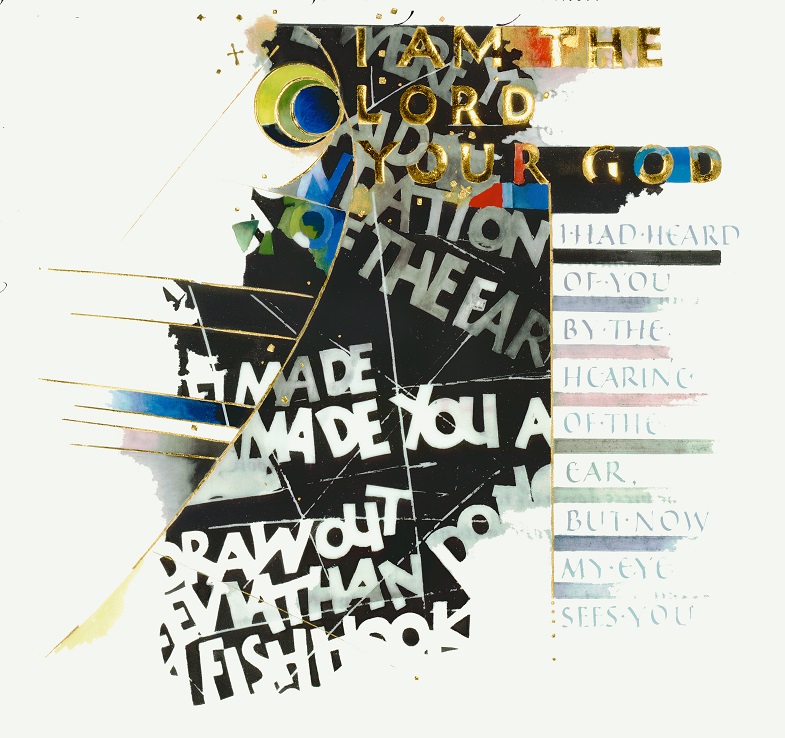
In the final illumination, “He Will Wipe Every Tear,” tension is resumed, but also re-characterized. Strings of words fly outward like trumpet blasts. Curiously, they are all from the beginning of the book. They announce destruction and the prominent words on the left, “The fire of God” draw our attention. Yet they are juxtaposed to straight, colorful, and orderly lines of Job’s satisfaction with God’s answer, “I know that you can do all things, and that no purpose of yours can be thwarted.” The foundation of this illumination is a colorful wall of words from Revelation 21:4, an eschatological summation of the peace at the end of Job. “He will wipe every tear from their eyes. Death will be no more. Mourning and crying will be no more. For the first things have passed away.”
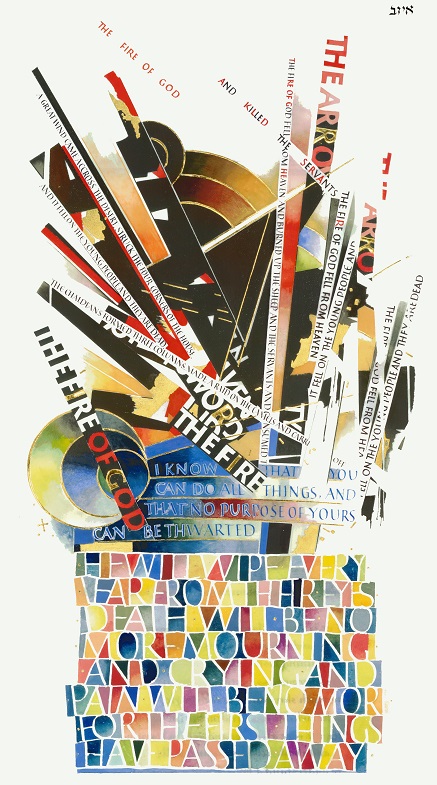
The Fear of the Lord is the Beginning of Knowledge, Proverbs 1
The text treatment of “The fear of the Lord is the beginning of knowledge” begins the book of Proverbs. Interlayed between these outlined words are golden lines of verses 7 and 8: “The fear of the Lord is the beginning of knowledge, / fools despise wisdom and instruction / hear, my child, your father’s instruction / and do not reject your mother’s teaching.”
Faint colored blocks jut in all directions behind these words. These blocks are from another illustration on the back of the page, ending the book of Job. Artist Thomas Ingmire purposefully layered the illustrations for this “show-through” effect, highlighting significant parallels between Job and Proverbs.
Verses 24 through 33 of Proverbs 1 reflect teachings similar to those espoused by Job’s friends: the wicked invite calamity upon themselves while the righteous “live at ease, without dread of disaster” (Proverbs 1:33). There is an understandable tension created by juxtaposing a thesis of Proverbs with the nearly identical antithesis of Job.
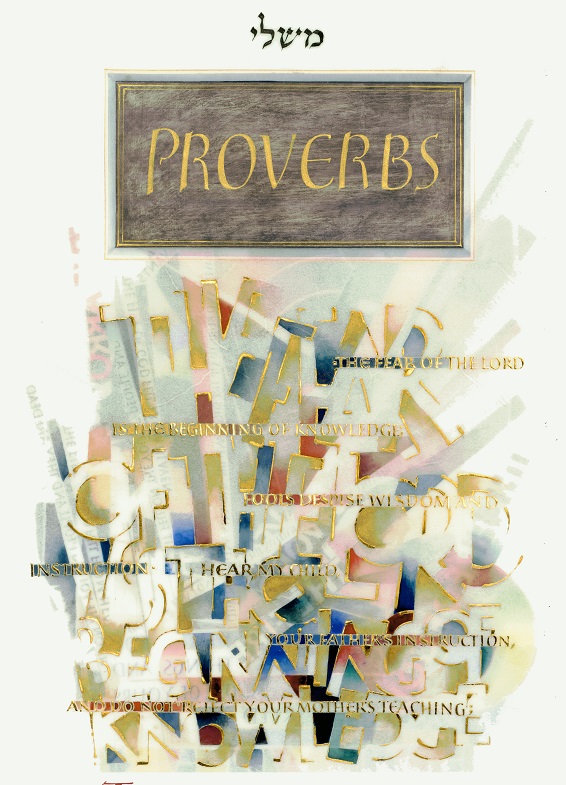
Seven Pillars of Wisdom, Proverbs 9:1
Seven is a symbolic number in the Old Testament, signifying completion or fullness. There is a perfection and fullness to the created order of Wisdom’s world. On each of the pillars is an orb that represents both a pearl, a precious thing of beauty created by mysterious processes, and that heavenly body associated with feminie forces—the moon.
The tree of wisdom takes center stage. Growing from another pillar is a complex of buildings, themselves built on columns and arches and with a series of arched roofs.
The cosmos stretches overhead, acknowledging Wisdom’s part in creation. Again in the sky a piece of the wisdom tree, here looking more like one of the heavenly bodies, reveals Wisdom’s presence. On the right hand page of the illumination, a table is set with wine and bread (cf vv 2—5).
One verse on the page stands out here because it is written in red instead of black. The cross in the margin tells us this verse is used in the Rule of Benedict. This verse and Proverbs 15:3 both appear multiple times in the Rule of Benedict and receive slightly heavier treatment here.
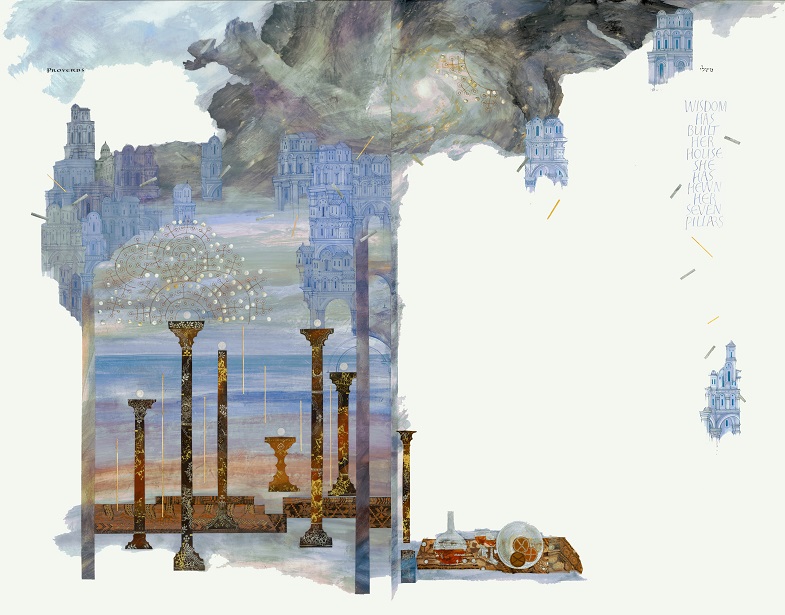

Hymn to a Virtuous Woman, Proverbs 31
The book of Proverbs ends with a hymn to the value of a good wife. This wife may be Wisdom herself, who has been sought throughout the book. The hymn closes out a book of instruction to a young man and logically ends with advice on what kind of woman to marry. This passage also marks a shift in speaker—it is the mother, not the father, who gives the son this advice.
This illumination is in the form of a sampler or tapestry, such as may be found decorating a home. Many of the aphorisms in Proverbs have been rendered decoratively as concrete words to live by. Embroidery is traditionally a woman’s art, and this illumination draws attention to the place of women in ethical instruction. The images themselves have a domestic quality, including water jugs, gardens, and quilt patterns. The treatment draws attention to God’s domesticity, helping us see God as a nurturer who looks after the well-being of the home.
The illumination also extends to the margins, framing the whole page with images of flowers, a vase, and a bee working a honeycomb. Another delicate detail is the tassels on the bottom, like those on the hem of a Jewish prayer shawl which remind the wearer to pray.
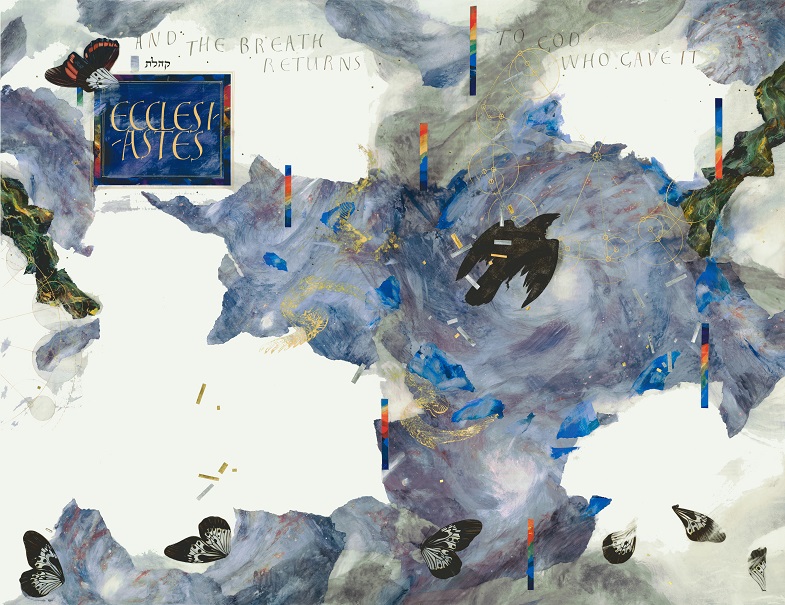
Ecclesiastes Frontispiece, Ecclesiastes 1
This frontispiece with its moody colors embodies the character of Ecclesiastes. While purple often represents royalty and splendor in The Saint John’s Bible, here it pairs with varying shades of blue and grey to create a dark cloud-like impression. The varying white hues give it the impression of a vapor (the literal meaning of ‘vanity’ in the book). As noted in the text at the top, “the breath returns to God who gave it.”
Elements of creation are all present here: The green of the earth stretches outward from each page. The blue water and tiny stars remind us of the first separation of the waters from the heavens (Gen 1:6-8). These elements, however, remain ghostly and chaotic. The bars of rainbow color are a sign of God’s persisting covenant, asserting itself against the otherwise chaotic image of the cosmos. Human intelligence also asserts itself here with the image of the ancient Islamic astronomical chart (the thin gold wheels on the right page).
Most prominent in the illustration is the dark raven, a common symbol o death, flying from its center. Birds are messengers, and this one seems to carry the breath of life back to God. Still, it is pierced and surrounded by gold and silver bars, designations of divinity. The golden seraph wings hail God’s kingship. Shattered butterfly wings bridge the human and divine realms. In fragments here, they speak to us of chaos and metamorphosis—life to death and death to life.
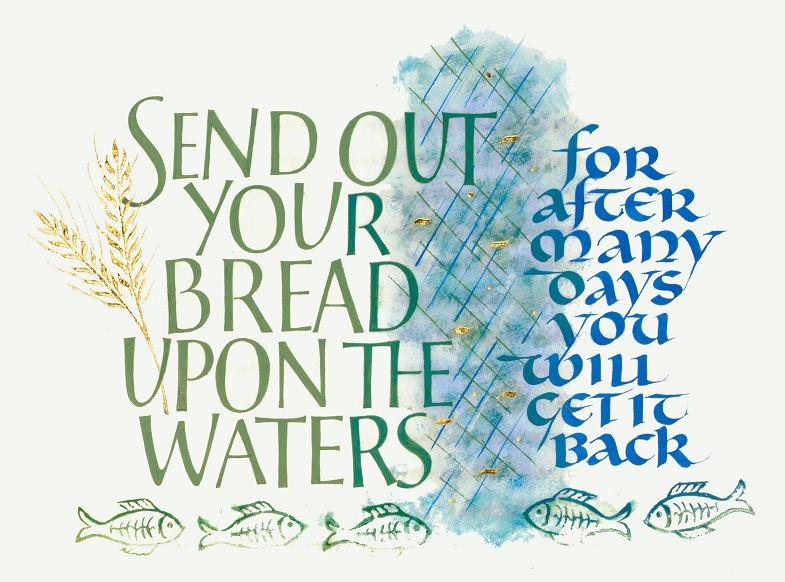
Set Me As a Seal Upon Your Heart, Song of Solomon 8:6-7
The text of Song of Solomon 8:6-7 is written not with a quill but with a reed pen. The split reed is light and writes like a quill pen dipped in paint except that its woody edge creates softer shapes. An earthly, primitive feel was created, emphasized by the variations of color.
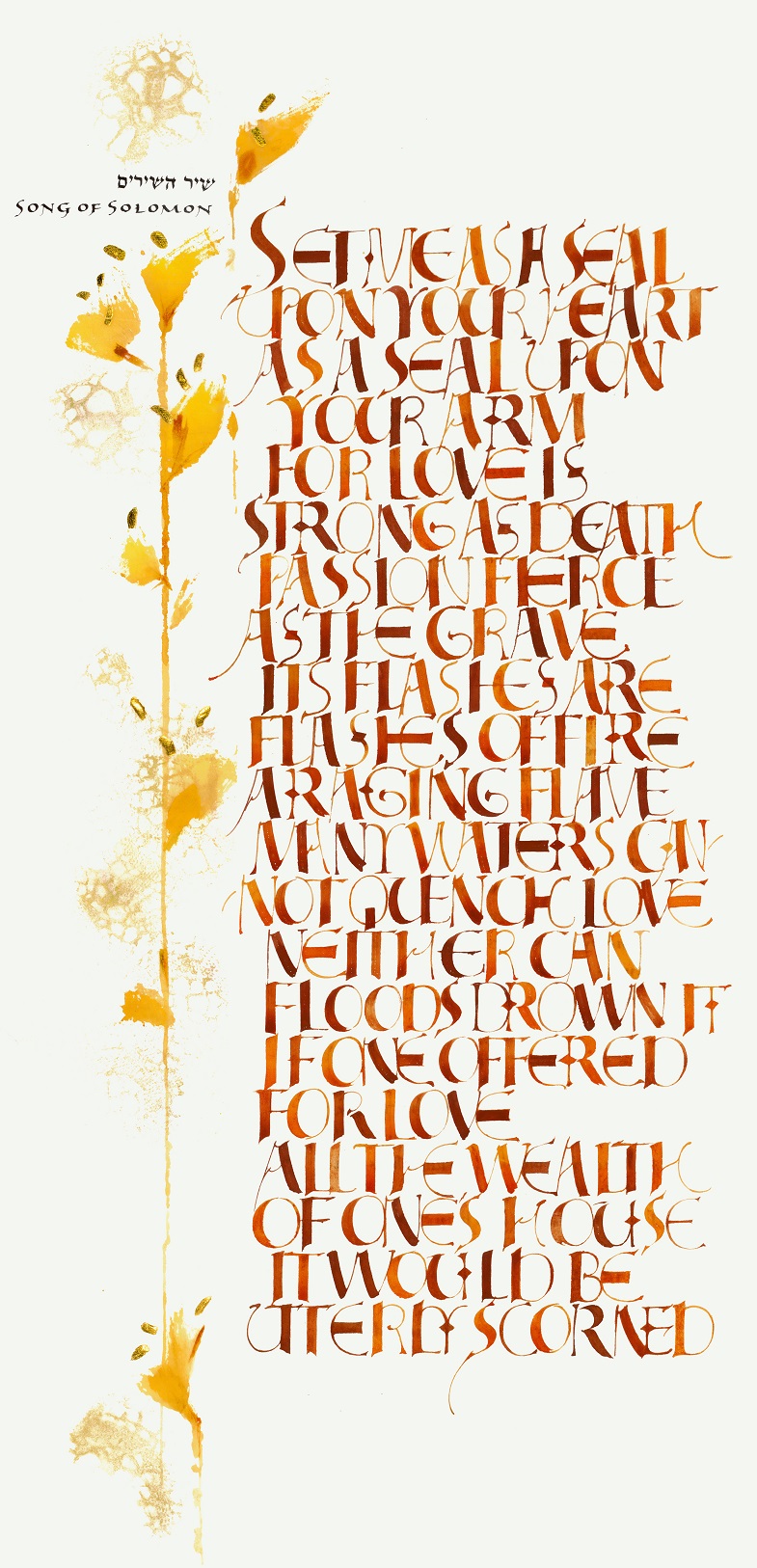
Correction Bee, Wisdom of Solomon 7:7b
Over the course of the project, each of the scribes made an error in the text that could not be erased. Here, Brian Simpson made his first (and last) mistake, leaving out two lines: “I called on God, and the spirit of wisdom came to me.” Head artist Donald Jackson decided that when the lines were omitted they should be written in at the bottom and their place in the text acknowledged.
Artists Sarah Harris and Donald Jackson worked out the design of the pulley system based on Leonardo da Vinci’s mechanical drawings, and Chris Tomlin came in to paint this whimsical bee doing some heavy lifting.

Creation, Covenant, Shekinah, Kingdom, Wisdom of Solomon 10—11

Chapters 10-11 in the Wisdom of Solomon recount the history of Wisdom from creation through the Israelites’ stay in the desert. The illumination on these pages celebrate Wisdom’s creative power and connection to human life. A series of four panels, bringing to mind the four elements of the universe: earth, water, fire, and air, are used to recount the stories of the Creation, the Flood, the Exodus, and the Promised Land. Connecting these panels are batons and frames of gold and silver, representing wisdom and divinity.
In the first panel, the seven days of creation are displayed in various widths, emphasizing the creation of humans and the coral snake representing the Fall. The raven of the first panel is complemented by the dove in the second—an image of the Spirit. Each of the first three panels breaks the boundaries of their respective images: the abundance of land breaks the first; a dove soars from flood waters, breaking the second; and destruction breaks the third. In it is the word “Shekinah,” God’s presence on earth.
The fourth panel takes a detail from the vision of Solomon’s temple in Ezekiel that focuses on the abundance provided to the people in the Promised Land and the eschatological meaning of the temple. Solomon sings the praises of Wisdom, who is with him, helping him to raise up a righteous kingdom.
